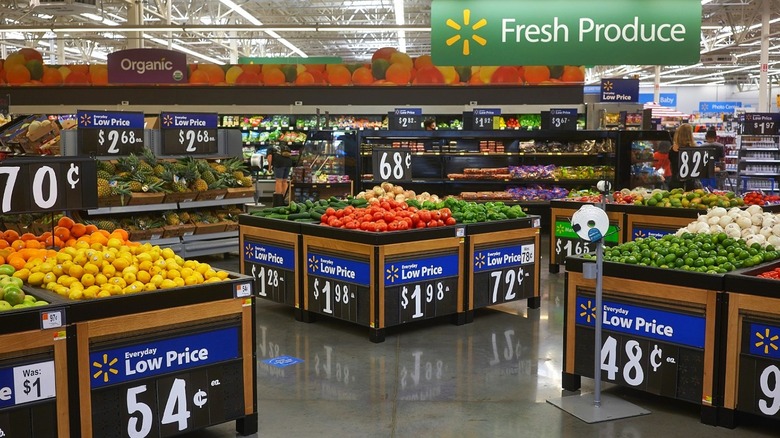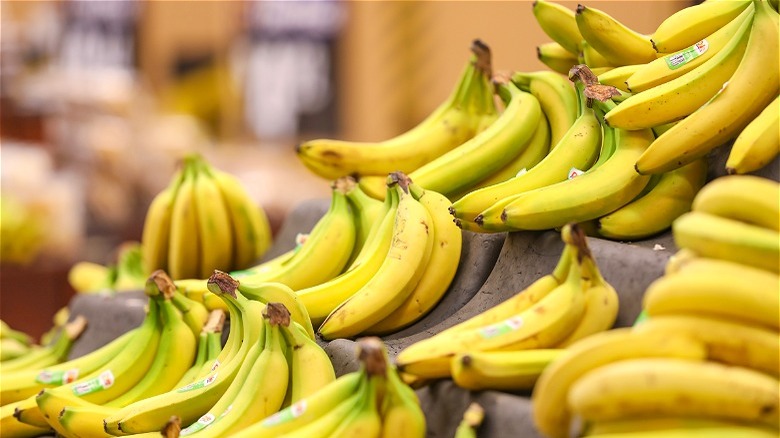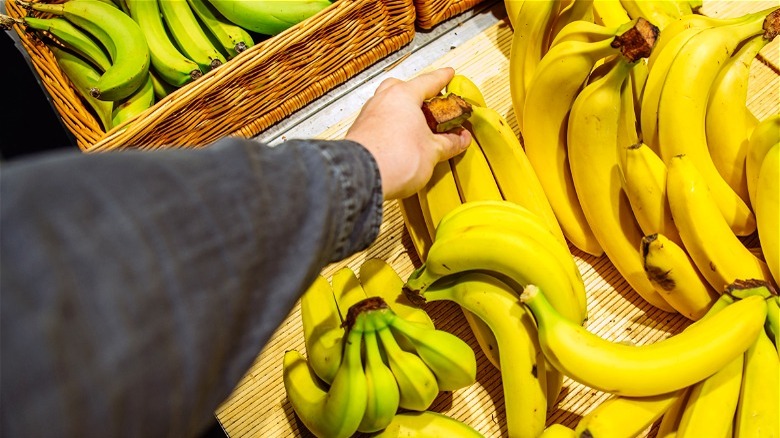The Fruit Walmart Has Sold More Of Than Any Other Merchandise
We may receive a commission on purchases made from links.
Walmart claims to operate under an "Every Day Low Price" mission, and cost-effectiveness is essential for those looking to save money at the supermarket. With over 10,000 stores worldwide, Walmart remains a dominant force in the consumer landscape due to its competitive prices, powerful bargaining strategies, and accessibility, says Insider.
No one can dispute Walmart's loyal customer base, but most consumers can agree that trying to adopt a healthy lifestyle is often expensive. According to statistics collected by the USDA, in 2021 strawberries were averaging close to $2.7 per pound, while Thompson seedless grapes cost an average of almost $2.5 per pound. Meanwhile, a 2016 USDA report revealed that, when following the association's Thrifty Food Plan designed for limited-budget households, the only way to satisfy the dietary guidelines for fruits and vegetables was to purchase produce on the very low end of the per-cup price range. So naturally, when money is a factor, many turn to cost-saving grocers like Walmart to eat healthy on a budget.
Based on a statement from the megastore in July 2022, Walmart continues to see increases in revenue through consumable purchases. When shoppers head to Walmart to buy their weekly groceries, items with the lowest price tags are sure to be among the most desirable when it comes to the produce department — and out of all the fruits and vegetables Walmart has to offer, there is one affordable fruit people choose more than any other.
Bananas are the most purchased item at Walmart
Bananas are the most popular item by far among Walmart shoppers, Walmart CEO Doug McMillon told Bloomberg in 2020. Mostly enjoyed raw or baked in one of many banana recipes, the long, yellow, grab-and-go snack was ranked in the top three most-consumed fruits in the U.S. based on a 2019 analysis by the USDA, and the most frequently eaten fresh.
Statista calculated the average cost of a banana in 2021 to be $0.62 per pound, yet Walmart sold them for less than $0.20 per pound in fall 2022. Walmart spokesperson Brooke Buchanan told Insider that bananas sell consistently based on that affordability, plus their portability and nutritious makeup. The numbers speak for themselves: Walmart sold over 1.5 billion pounds of bananas in 2015, the vice president of Walmart's produce and floral department Dorn Wenninger claimed to Insider.
Walmart may also have a leg up on other big-box retailers since its 2019 produce makeover. According to CNN, the chain made major strides to create an "open market feel" for customers. The retailer also made a special effort to revamp signage and streamline produce displays, creating a higher level of accessibility for the everyday shopper. But as more people are drawn to the produce section to load their carts with bananas and fulfill their daily fruit intake in a cost-effective way, buyers may also want to consider the higher long-term cost of getting this fruit at such a steep discount.
Is there an unforeseen cost behind the affordable banana?
With the ever-looming threat of inflation, most consumers aren't disputing the costs saved by buying cheaper food. Yet, for those who pause to question why bananas are so cheap, the story is a long, complicated one that involves unseen environmental costs and hyper-control over an international market — one that is now easily perishable due to rampant banana production and the potential threat of disease, warns The Counter.
The Counter explains how bananas became accessible to Americans in the late 1800s because big businesses' unrelenting command over production and distribution aimed to keep costs low, which is still the case today. According to Vox, the modern market is primarily driven by the Cavendish banana, the most popular variety sold in the United States. This banana reproduces asexually by cloning, unlike many other fruits. While this makes the product standard and predictable to grow, sell, and eat, it has also created the potential for devastating consequences: Apart from the environmental effects of fossil fuel emissions to get so many bananas to the U.S., ailments like Tropical Race 4 have the potential to wipe out large banana crops.
Vox reveals that if one plant becomes diseased, the threat becomes high for all cloned banana plants due to a lack of varied genetic makeup. So while major retailers work to keep customers coming in for predictably-priced bananas, without distributors working to diversify the banana market, consumers shouldn't be surprised to see a markup of this popular fruit in the future.


